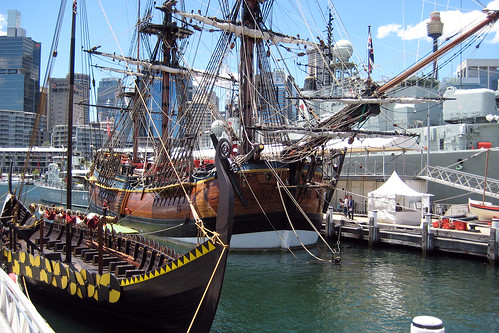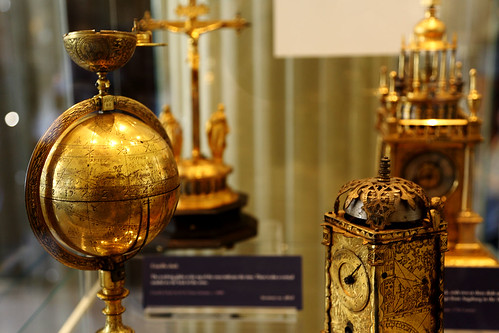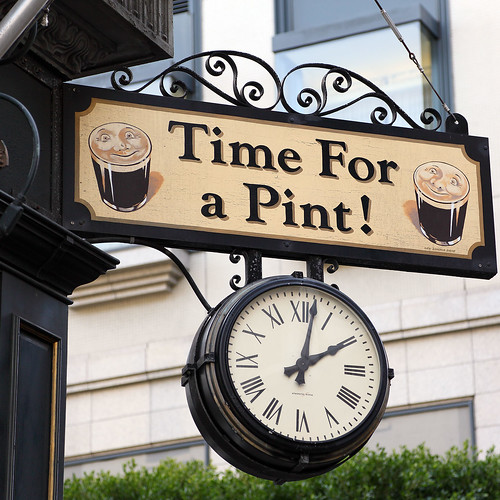

| Archive Blog Cast Forum RSS Books! Poll Results About Search Fan Art Podcast More Stuff Random |
|
Classic comic reruns every day
|
1 {photo of a complex brass clock mechanism}
1 Caption: Like clockwork
|
First (1) | Previous (3340) | Next (3342) || Latest Rerun (2890) |
Latest New (5380) First 5 | Previous 5 | Next 5 | Latest 5 Annotations theme: First | Previous | Next | Latest || First 5 | Previous 5 | Next 5 | Latest 5 This strip's permanent URL: http://www.irregularwebcomic.net/3341.html
Annotations off: turn on
Annotations on: turn off
|
 Modern sun worshippers at sunrise. |
For much of human history, timekeeping was regulated mostly by the sun. The rising and setting of the sun breaks human time into parcels we call days and nights. The nights are dark and humans like to shelter and get sleep during these hours, while the days are well lit and allow humans to go about their business of hunting and gathering food.
Night time would have been a time of trepidation, as human defences are at their weakest and several dangerous predators use the cover of darkness to hunt large prey. In this context, the daily rising of the sun would be greeted with palpable relief and a certain amount of celebration. When you stop to think about it, it is not surprising at all that most early human cultures revered the sun as a major deity, if not the single most important god overseeing their lives.
Hunter-gather societies pay attention to the yearly cycle of seasons, because animals and plants do. Migrations of prey animals occur at predictable times of the year, assuming you have the knowledge to predict those times. And when we became farmers, these slices of time longer than a day became even more important. Growing crops also requires knowledge of the seasons. So we became proficient at counting the days between the cycles of warmer and colder weather, and used more subtle movements of the sun and the stars in the sky to mark those (I've talked a bit about this before). But smaller slices of time were judged only as rough fractions of a day, reckoned by the passing of the sun from east to west during the day or simply by our innate sense of time ("it feels like about half the day has passed").
 Candles still mark the passing of time... |
Whatever the need, people applied their inventiveness to the task. Some early timekeeping devices include candles, whose lengths were marked in intervals. As the candle burnt down, it recorded the passing of time. Another device was the water clock, in which water filled a vessel with a tiny opening allowing the water to drip out slowly. The sinking water level marked the passage of time. These devices were affected by their surroundings or their own properties (such as the reduction in water pressure over time) so that the rate of burning or dripping changed, making them rather inaccurate. What was needed was something that kept time more regularly.
That something was available for many hundreds of years before anyone realised it. The first recorded person to make the necessary observations was Galileo, around the year 1600. He was curious about the properties of an object suspended by a rope or a string, and freely swinging to and fro. He timed the swings of such objects with the best short-period timekeeping device he had available - his own pulse. Galileo made the observation that (to the best he could determine) the time it took such a device - a pendulum - to swing back and forth once did not change as the size of the swing changed. If you took a weight and hung it on a string and swung it gently, it would move slowly back and forth over a short distance. If you push it harder it would move faster, but the swing would be longer. The extra speed compensated exactly for the extra length, with the result that a single long, fast back and forth swing took the same time as a single short, gentle swing. Galileo also determined that the timing of the swings did not depend on the weight of the object at the end of the string. It only depended on the length of the string.
 The oldest working mechanical clock in the world, in Salisbury Cathedral, built in the 13th century. |
Mechanical clocks had existed for a couple of centuries by the time Galileo did his pendulum experiments. They were powered by what we now know as clockwork - a more or less intricate collection of interlocking gears driven by a power source such as a falling weight or a tensed spring. The problem with these clocks was that their speed tended to vary as the weight fell or the spring relaxed, because the force driving the mechanism changed. There was no good way of regulating the speed of the clockwork. Various mechanisms were tried, but the resulting clocks were poor timekeepers, drifting a quarter of an hour or more over the course of a day.
The pendulum, with its regular motion, provided the breakthrough. By linking the back and forth motion of a pendulum to a rocking arm with teeth which could stop the motion of a turning gear, Christiaan Huygens[1] built a clock in 1656 with a gear that rotated reliably by exactly one tooth for every swing of the pendulum. Typically these escapements, as they are called, have teeth at either end of the rocking arm, stopping the gear twice for each to and fro swing of the pendulum, once as it swings one way, and once on the return swing. This led directly to the familiar "tick tock" sound pattern which has survived in mechanical clocks to the present day. Adding a pendulum-controlled escapement to mechanical clocks immediately improved the accuracy of these timepieces roughly a hundred times - they would now drift only a few seconds every day. Until the late 20th century, nearly 400 years later, this was good enough for most human timekeeping purposes.
But there was still one major problem related to timekeeping. It had to do with navigation at sea. By the 1600s, European ships were plying the seas, discovering lands, establishing colonies, and setting up trade routes. To get to where you're going, you need to know where you are. If you're at sea, out of sight of any landmarks, you can do this by looking at the regular movements of the sun and stars.
The pole star, Polaris, always sits directly above the North Pole. If you measure its angle above the flat horizon of the sea, that immediately gives you your latitude. This works anywhere in the northern hemisphere. If you're south of the equator, you won't be able to see Polaris at all, but you can do the same thing with the fainter group of stars known as Octans, which sit near enough to the South Pole. During the day, you can measure the height of the sun and perform a quick calculation depending on the season of the year and deduce your latitude that way.
Longitude is a whole different kettle of fish. Latitude is easy to measure because the Earth doesn't move north or south. However, the Earth rotates west to east. The positions of the stars look pretty much identical from one spot on Earth as they do from a spot 15° of longitude to the west one hour later - because in that hour the Earth's surface has rotated by 15°. That 15° of longitude corresponds to different distances, depending on your latitude (because the Earth's surface is spherical, not flat); at the equator it corresponds to a whopping 900 nautical miles (1667 kilometres). If you happen to know the time accurately you can calculate your position from the stars, but if you have the time wrong by just one hour, you will get your position wrong by up to 900 nautical miles. Similar problems occur with the sun (modified very slightly by the fact that the sun moves across the sky at a slightly different speed to the stars).
 It's difficult to tell time on a ship like this. |
The difficulty was that you couldn't simply take a 17th century clock on a ship. The rocking of the ship messed up the swinging of the pendulum, which made the clockwork irregular. The large changes in temperature experienced at sea also affected the regularity of clockwork as mechanical components contracted and expanded due to thermal expansion. Clocks of the period simply could not keep accurate time on a ship. The only solution to this crucial problem of oceanic navigation was to find a way to tell the time accurately on board a ship.[2]
There were actually two competing methods potentially available to do this. The first and most obvious is to design and build a better clock, one capable of keeping time even under the incessant rocking and large temperature variations of a ship. While obvious, this was incredibly difficult to do with the technology of the time. Most attempts tried to isolate the clockwork from the rocking of the ship by various arrangements of pivots and gimbals, but this didn't work very well.
The second potential method was to calculate the time by observing astronomical phenomena. Unfortunately most astronomical bodies move too slowly to be of any practical use for keeping time accurate to a minute or less. But there were two different objects that might do the trick.
The first is the moon. It's not obvious by eye, but the moon moves across the field of stars by a detectable amount in the space of a few minutes. By measuring very accurately the position of the moon relative to nearby bright stars, and then consulting accurate tables of lunar positions, you can work out the time. This method is known as luna distance. The problem was observing the moon's position accurately enough from on board a rocking ship, and the accuracy of the lunar position tables.
A second method involves the four largest moons of Jupiter[3], which revolve about the giant planet with orbital periods ranging from 1.7 to 17 days, and on each revolution they are eclipsed by the planet so they vanish from sight. These eclipses happen at regular and predictable times, so if you observe one happening, you can pinpoint the time to an accuracy of a minute or better.
 Old clocks. |
The clockmaker John Harrison eventually solved the longitude problem with mechanical clocks built to ever finer specifications, isolated from the rocking movement of the ship, and with clever use of materials to compensate for temperature differences. Several books tell the story, which is a rich mixture of naval exploration, colonial politics, science, and extremely clever engineering. For further reading you can try Longitude, by Dava Sobel.
And so eventually we had clockwork clocks that actually did "run like clockwork". These have since been far exceeded in timekeeping accuracy by clocks based on vibrations of crystals or atoms.
 After all this writing... Yes, I think so! |
It recalls the Camille Flammarion engraving, of the man thrusting his head through the veil of the heavens to marvel at the clockwork mechanisms which keep the universe in motion.
Tick. Tock. Tick. Tock...
[2] At least, the only solution even imaginable with 17th century science. There are a few other solutions to the problem of finding your longitude at sea.
You can launch satellites and triangulate timing radio signals off several of them to fix your location relative to the satellites. We call this method the Global Positioning System, or GPS.
You can make radio observations of several pulsars and time their pulsation rates to fractions of milliseconds. Pulsars generate radio pulses at regular intervals and are outside our solar system, so the timing rate of the pulses is affected by Doppler shifting caused by (a) the movement of the Earth around the sun, and (b) the rotation speed of the Earth. As long as you know the date (to account for the yearly motion), you can work out precisely where you are based on which direction the bit of the Earth's surface you are on is moving as it rotates.
[3] Called the "Galilean moons" in an astonishingly appropriate bit of nomenclative serendipity, since Galileo discovered them around ten years after his pendulum experiments, with his brand new telescope.
|
LEGO® is a registered trademark of the LEGO Group of companies,
which does not sponsor, authorise, or endorse this site. This material is presented in accordance with the LEGO® Fair Play Guidelines. |